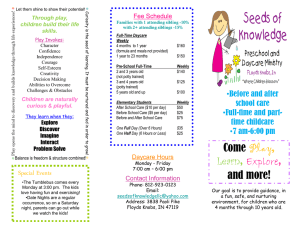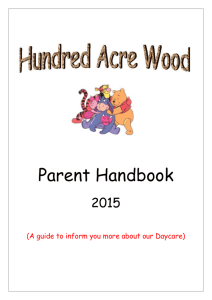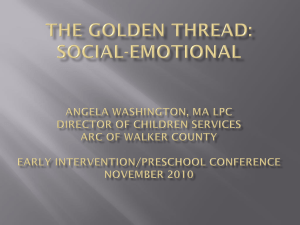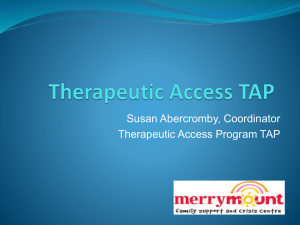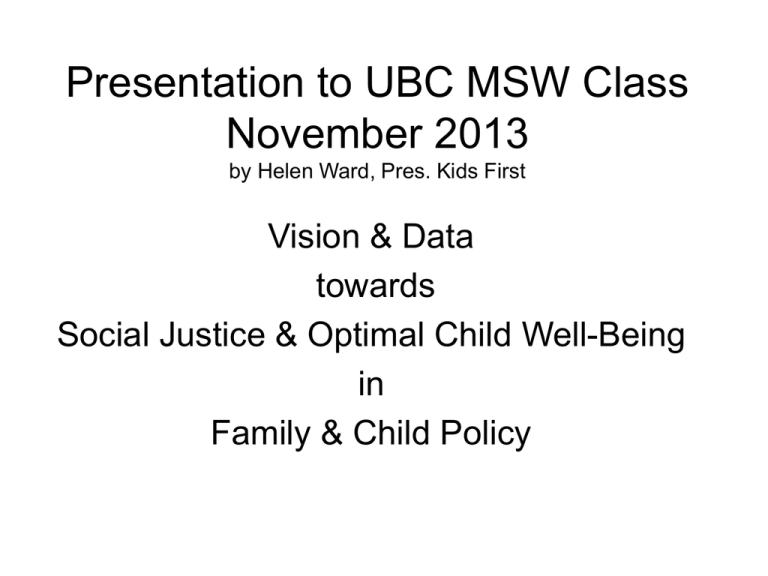
Presentation to UBC MSW Class
November 2013
by Helen Ward, Pres. Kids First
Vision & Data
towards
Social Justice & Optimal Child Well-Being
in
Family & Child Policy
About Kids First Parent Association
of Canada
•
•
•
•
•
•
1987
Registered charity - DONATIONS!
Independent
No $ from gov’t, union, corporate, faith grp
Volunteer parent-run
International movement for…
–
–
–
–
women’s unpaid care work
& all unpaid care work
& equity for parental child care
& children’s optimal well-being
My Background
•
•
•
•
•
•
Stable middle class educated parents
FT job mum
BA, BMus, TESL
Care-work
Performing
teaching
Social Justice
• Anti-racism, inter-faith
• Philippines – role of Transnational corporations,
IMF, World Bank in exploitation
• NDP
• Peace movement
• Greenpeace, Wilderness Ctte
• Amnesty International
• Council of Canadians
My early intro to motherhood
•
•
•
•
•
•
Friend’s pregnancy – women sharing
Natural childbirth
Home birth
Midwifery
Breastfeeding
Bonding (attachment)
Books
• Ina May Gaskin - Spiritual Midwifery
• Joseph Chilton Pierce - Magical Child
My Turn – My Vision for My
Motherhood – Do’s
• Build life long foundation for health
-Breastfeed on demand
-organic food
• Carry and hold, pick him up when crying
• Cloth diapers
• Attach to earth/nature – forest, ocean,
animals
• BUILD VILLAGE - Attach to extended
family, neighbourhood, all ages
• Attach to music, literature, art, history
• Inculcate empathy – love and justice
My Turn – My Vision for My
Motherhood - AVOID
•
•
•
•
•
Medicated birth
Toxins
Allergies, eczema, asthma
Screens, TV
Advertizing, consumerism, commodified
culture
• Junk food
La Leche League
PARENTAL EMPOWERMENT
• Honour, support, celebrate, and enjoy
motherhood & fatherhood & family
More Books
•
•
•
•
•
•
•
•
•
•
The Continuum Concept
The Family Bed
The Womanly Art of Breastfeeding
Will & Martha Sears - Night Time Parenting, etc
Ivan Illich - Deschooling Society, Gender, Right
to Useful Unemployment
The Politics of Breastfeeding
Marilyn Waring - If Woman Counted
Mate & Neufeld – Hold on to Your Kids: Why
Parents Need to Matter More than Peers
Sue Gerhardt – Why Love Matters: How
Affection Shapes a Baby’s Brain
Penelope Leach – Children First
CHALLENGES! And
COMMITMENT
• LICO
• single parent
• etc
Committed to prioritizing doing the care
work
RISING PROBLEMS WITH
YOUNG
•
•
•
•
•
•
•
•
•
•
•
•
•
•
Suicide
Self harm, cutting
STDs
sexual exploitation
Substance abuse, addiction
Bullying
Obesity
Violence, riots
Excessive screen use & digital addictions
Prescription drugs for mental health and behaviour modification
Allergies, eczema, asthma
Cheating, lying
Falling academic ability
Non-participation in voting
The issue
• EVERYONE AGREES THAT THE EARLY YEARS ARE
IMPORTANT FOR LIFE LONG OUTCOMES
BUT!!!
• COMPETING VISIONS
• COMPETING WORLD VIEWS/PHILSOPHIES
• Who should control early learning & care?
• Who should control the public funding for children and
their families?
My Intro to Daycare Lobby
• Living under regulated Lic Not Required
daycare
• RCMP informs daycare about grow-op
• Special entitlement to info
• 1999 secret “public consultation”
• Building a Better Future for BC’s Kids
Kids First is 100% in favour of early
learning and child care
HOW DO WE DEFINE “CHILD CARE”?
WORDS MATTER!
DEFINE CHILD CARE
• Child care means “care of a child”
• Includes parental child care
• Early learning is the learning that a child
does in any situation
• All children need child care 24/7/365
• All child care & early learning has high
COSTS
• Primary cost is supporting the care
provider
DEFINITIONS & DISCRIMINATION
• Different laws, studies, and statistics use
different definitions of “child care”
• BC Child Care Act, Child Support laws,
and the Tax Act define child care to
specifically exclude parental child care
Human Rights
• This exclusion is a Human Rights issue
• The UN Convention on the Rights of the
Child says
- Children have the right to be cared for by
their own parents – article 7
- Gov’t must respect the rights and duties of
parents to interpret children’s rights –
article 5
Human Rights
• BC and Can Human Rights Codes protect us
from discrimination based on
- Family status
- Marital status
These Human Rights laws can be used to
overturn laws which discriminate against
parental child care, especially as these laws
target single mothers and their children.
PARENTS
• Are held legally, socially, morally responsible for children
– eg RIOTS, gun violence…
“Where are the parents!!?”
• BC Parental responsibility Act
• are the people held personally legally criminally liable for
children’s care & supervision.
• Are in the best position to know their children
• are diverse – health, $, jobs, schedules, family size,
support, beliefs, etc NO 2 FAMILIES ALIKE
• are told by gov’t to closely monitor any non-parental child
care.
PRESSURED PARENTS
• High pressure
• NOW - EXTREME EXPECTATIONS
- SAFETY – car seats, PREDATORS
- constant supervision
- car - drive
- monitor screen, TV
- can’t play outside
- advertizing, porn
- lessons & activities Sports, music, swim , etc - homework
- HOUSING COST
POLICY CREATE THE SOCIAL
CONTEXT FOR CHILD REARING
CURRENT POLICY HOSTILE TO
PARENTS & CHILD REARING
• GDP growth #1 national goal
• GDP growth thru’ “professionalization of care” – replace
SOME unwaged care with waged care
• Non-GDP activities disvalued – eg cooking,
breastfeeding, unwaged care work
• Preferential funding for non-parental care disvalues
parental care
• BUT this work is ESSENTIAL TO EXISTENCE OF
SOCIETY
• Increase LABOUR SUPPLY = lower wages
• FT jobs for all parents BUT do home cooking, monitoring
kids all the time
• 1980s Pres Reagan ended regulations on kids ads
UNWAGED CARE WORK
SUBSIDIZES GDP WORK
• Exploitation of unwaged care workers
• Unfinanced unwaged care work produces
low-wage care work (nannies, staff, home
daycare) – over 95% women
• Need recognition for and adequate
financial support for unwaged care work
• BEGIN - THANK PARENTS
FAMILY & CHILD POLICY
•
End preferential treatment of non-parental child care/early learning
•
Direct funding for children’s care & learning to families eg through a
universal refundable tax-credit to age 19
(welfare, EI, UCCB, CTB, CCED, ELCC, K, etc)
•
Drop OECD/World Bank policy goal of “shared responsibility” between state
and parents for child-rearing
•
Explicitly recognize attachment theory & developmental science in policy
formation
•
Drop GDP growth as primary national goal
•
Adopt alternate measures of national well-being and economic growth
•
Eliminate toxins affecting children
•
•
•
Restore restrictions on advertizing to children
Make public transit free to age 13
Ensure daycare regulations do not compromise child development: ratios
BC Child Care Policy Branch
Approved Research
• Dr Clyde Hertzman, UBC – HELP
- World Bank staff, epidemiologist
• U of T econs Cleveland & Krashinsky
- $1 invested=$2 saved
-not peer-rev, huge PR, CRRU publication, cited by PM
• Fraser Mustard & Margaret McCain –
Early Years Study: Reversing The Real Brain Drain
-not peer-rev, World Bank stressed, blood specialist +
billionaire
• High/Scope Perry Preschool Project to age 27
-peer-rev: $1= $7 1962, not daycare, mums, pre-welfare
reform/workfare, intervention
BASIC FACTS &
DEFINITIONS
Check the facts.
Demand truth.
COST:BENEFIT FINDINGS
• Claims that universal daycare/all day K produce
long term savings over costs are not peerreviewed
• published by advocacy orgs
• $1 “invested” saves
$1.05 (Fortin – Que daycare)
$2 (Cleveland & Krashinsky)
$2.?? (Prentice)
$17 (Perry Pre-school)
and even “limitless” (BC Min of Educ)
ACADEMIC MISCONDUCT
- “jaw dropping…gross
misrepresentation”
of Nobel Laureate economist James
Heckman - UBC econ – Kevin Milligan
- UBC’s HELP’s Hertzman and Kershaw
claimed Heckman supports these
universal programs
ACADEMIC MISCONDUCT &
POLICY
- Based on misrepresentation of HECKMAN
HELP told business, media, BC & Fed
gov’t:
- BC will save $400 BILLION & Canada
could save over $3 TRILLION by investing
in daycare + all day K + EI to 18 mos
(HELP 15 by 15, submission to Finance Ctte
2009)
HECKMAN & COST:BENEFIT
• “none of this evidence supports universal preschool
programs”
(The Productivity Argument for Investing in Young Children p 38)
• $1 saves $6 long-term for a few mother-intensive programs for very
disadvantaged inner city children (eg Perry Pre-school)
•
•
•
•
Vouchers for under-privileged families
“respect” for parents
“we don’t know” what program works best – variety
Not “government bureaucracy” but programs run by community and
faith group
From “An Interview with James Heckman” pp 24-29
www.bernardvanleer.org/Family_stress_Safeguarding_young_childrens
_care_environment
Work vs Labour Force Participation
• NOT TRUE
• “70-80% of mothers are
working”
• “in paid workforce”
• “full time”
• “outside the home”
• “including infants and
toddlers”
• 2012 LFP mums
youngest child age
0-2 = 69.7%
3-5 = 76.6%
BUT
Children 0-5 with
“employed” mothers
= 67%
(CRRU ECEC 2012)
Work vs Labour Force Participation
•
•
•
•
“every mother is a working mother”
“work is work” includes unwaged care work
LFP is NOT “work”
1880s census changed the definition and
suddenly half the women were no longer
counted as productive (Politics of Breastfeeding)
• Inflated abused stats distort our perception of
reality
• Mothers’ LFP rates are a false proxy measure of
daycare demand
Work vs Labour Force Participation
• LFP rate is NOT “work”
LFP
• incl
Employed
Unemployed
=
-Looking for work
Not in Labour Force
“inactive”
“not working”
“leisure”
MISOGYNY
Work vs Labour Force Participation
Employed
Have job & not at it
-paid leave
-unpaid leave
-EI
Any paid work
-Any part time
-with kids present
-in home
Unpaid work
-farm
- family business
ENROLMENT IN DAYCARE
CENTRES
• YOUR ESTIMATE?
ENROLMENT IN DAYCARE
CENTRES
•
•
•
•
2000 – 10% 0-5
2006 – Stats Can – 14.9% 6 mos-5 yrs
Find this stat buried on p 97 of 99 p report
Stats Can media release said “54% in child care”
• MOST PEOPLE GROSSLY
OVER-ESTIMATE THIS DUE TO PERVASIVE
DIS-INFORMATION
• DISTORTED PERCEPTION=DISTORTED
POLICY
False Measures of Daycare
Demand
• “waitlists” (3 years etc) – not valid
• “licensed spaces” (for 20%)
• Enrolment
MEASURING TRUE DEMAND
REQUIRES DEMOCRACY…
• Full INFORMATION – quality, outcomes,
costs
• ASK the right questions
• DEFINITIONS - Clearly defined terms
• REAL CHOICE - Providing full range of
options
• DEMOCRACY OR STATISM?
What kind of feminism works for
you? The GDP?
• Simone de Beauvoir in The Second Sex 1949
“No woman should be authorized to stay at home with
her children….Women should not have that choice
precisely because, if there is such a choice, too many
women will make that one.”
ARE WOMEN COMPETENT TO MAKE CHOICES?
OR
SHOULD STATE “PATERNALISTISM” COERCE
WOMEN’S CHOICES?
Neo-liberal Neo-patriarchy
HELP’s Paul Kershaw
in “Carefair: Gendering Citizenship ‘Neo-Liberal’ Style”
“utilize the state’s coercive power for
the purpose of altering citizenry
decisions”
Strategy model = in neo-lib/-con welfare reform and
workfare as in Lawrence Mead 1986 Beyond Entitlement
Women’s Liberation
vs Gender Equity
• What happened to “women’s lib”?
• Who invented “gender equity”?
- measures women’s status by comparing us
to men
- World Economic Forum measures “gender
equity” by % of women in Labour Supply
- What women want, rape, abuse are not
counted
POLLS
• 2013 – IMFC
-76% parental care best for child under 6
- 61+% say funding to families not daycare system
• 2004 – Vanier Inst
- 9 of 10 prefer parental care
- daycare centres ranked 5th
• 2006 - SWEDEN
- 64% gov should fund parents to look after kids to age 4
(9% don’t know)
Sources at www.kidsfirstcanada.org/polls-on-funding.htm
COSTS
MUST INCLUDE “ALL COSTS” – Rand Corp.
CENTRE CARE COSTS ARE THE HIGHEST
-operating costs
-capital, land
-rent
-gov’t oversight
-training
-research, promotion, advocacy
-“negative externalities” – infection, behaviour
COSTS
Parental care
Opportunity costs – eg foregone income
SOME DOLLAR COSTS
• Quebec - $7/day system – 2010 – per space subsidy
paid to non-profit centres
- $17,913 age 0-17 mos
- $12,406 age 18-59 mos
- $9,000 – in family based daycare
(Haeck, Lefebvre, Merrigan – “Quebec’s childcare…10
years after” 2012 p.14
• $26,972/yr – 2007 Sweden – average daycare subsidy
per child age 1-5
www.kidsfirstcanada.org/SwDaycarecosts.pdf
COMPARE WELFARE RATE
• BC single parent with 1 child
• Youngest must be under 3
• $11,340/yr (12 mos x $954.month)
COSTS ARE NOT FEES
• Daycare is heavily subsidized even for high
income families
• 50% centre operating costs are covered by gov’t
(CRRU ECEC 1998)
• UBC fees – FT infant care $1100/month
• UBC pays all rent, janitorial, and admin costs.
EXCLUDING RENT is $1800/yr/child.
QUALITY - RATIOS
• Peer-reviewed empirical evidence – HARD
TO FIND:
• One study:
• -no children under 14 mos in study
• 50% of children do not receive adequate
developmental care or physical care at
adult:child ratios of…
% children receive inadequate care
when ratio is….
50% - 0[14]-24 mos:
1:3
40% - 25-36 mos: over 1:6
50% - 37mos-4.5yrs: 1:8
BC
1:4
1:4,1:8
1:8
K 1:22
Quebec
1:5,1:8
1:8
1:8,1:10
4yr K 1:18
5yr K 1:20
• “Thresholds of quality: Implications for the social
development of children in center-based care.” Child
Development, 63 1992
www.cckm.ca/ChildCare/pdf/Howes1992.pdf
Current Regulations Ensure LowQuality Care
• Gov’t-regulated care is low quality
• Regulation by gov’t currently ensures lowquality care for majority in centres
-ratios
-group size
• Parents MUST regulate
• Children’s Charter right to “security of
person” is violated by gov-regs
STUDIES ON QUALITY OF CARE
• Peer-rev - US – National Institute for Child Health and Human
Development MOST IN DEPTH ‘GOLD STANDARD’ STUDY OF
CHILD CARE EFFECTS
- NICHD data shows highest quality of non-maternal child care was
in father and grandparent care, lowest quality was in centres
• Sweden - Swedish gov & OECD (not peer –rev): Swedish daycare
has “problem of quality”: too many children per staff, inadequate
staff training, inadequate facilities, negative impact on long-term
learning
• Canada - You Bet I Care!1 – HRDC - 2000 (not peer-rev) “majority
of licensed daycare in Canada is minimal to mediocre quality”
does not meet children language and development needs
• Canada – Quebec - Quality Counts!- IRPP – (not peer-rev):
73% of centre care is “minimal” or worse than minimal
OUTCOMES:
H.E.L.P.’S STUDIES VS HELP POLICY
•
“Pro-social behaviour scores were lowest for children in
licensed day care and highest for children in unregulated home
care and relative care.”
Statistics Canada “National Data Sets: Sources of Information for
Canadian Child Care Data” by Hertzman and 2 other HELP staff,
p.14
http://www.statcan.ca/english/research/11F0019MIE/11F0019MIE20
06284.pdf
• “participating in early childhood care and education programs
and services at the age of 2 and 3 had little direct association
with children's home and school outcomes in Kindergarten.”
HELP, “The association of early childhood care and education to
children’s experiences in Kindergarten” February 2006 by
Hertzman, Kohen, Lipps (removed from web)
HELP’s EDI Junk Science
• All-day K was implemented in BC and Ont based on HELP’s claim –
cited by both Premiers - that
30+% “at risk”, “stunted”, “vulnerable”, “not ready” – HELP’s
interpretation of Early Development Instrument (EDI)
• Over 10% vulnerability is “biologically unnecessary” - Hertzman
• BUT EDI website says ONLY 5% - mostly ESL, boys, younger
“1 in 20 children enter kindergarten without the skills they need to
learn”
www.offordcentre.com/readiness
HELP 15 by 15, Pascal With a Better Future in Mind
PEER-REVIEWED OUTCOMES
• NICHD to age 15: more time in daycare
centre associated with significantly
increased “risk” behaviour at age 15
• Duke University – 2010 – all-day K vs half
day: produced slight academic advantage
that faded by Gr 3, as well as behaviour
problems
Peer-reviewed Outcomes
• Baker, Gruber, Milligan – 2010 – Journal of
Pol Econ – Que – $5/day daycare had
negative impact on child and parent
health, parenting, behaviour, children
better off before the policy
• Haeck, Lefebvre, Merrigan (2012 – in rev.
now) – Que – “Que Childcare…10 years”
- social inequity, high cost, lower academic
outcomes and worsened behaviour
ILLNESS
• Feces, saliva, mucus and kids’ poor hygiene skills make daycares
unsanitary
• Que daycare children - 6 mos URTI cost estimated at $1million
• Many studies have shown increase rates of infections of all types
and more serious illness in children in centres
• Sweden: daycare kids are 6.78X more likely to be sick than kids in
parental care
• “super-bugs” originating in daycares
• Centre gets funding for sick children who must be cared for
elsewhere
CORTISOL=STRESS
• Cortisol is released under stress and is involved in the
development of self-regulation and well as immune
system
• Studies repeatedly show elevated cortisol levels in
children in centre care
• “Centre-based child care is associated with
increased reactivity of the hypothalamic-pituitaryadrenal (HPA) axis.”
• Watamura et al Child Development 2003, 2012, etc
www.pubmedcentralcanada.ca/pmcc/articles/PMC32952
36/
Cortisol and Attachment
• ATTACHMENT to teacher reduces
this problem
Which Kind of Attachment?
• Labour Force Attachment
• VS
• PARENT-CHILD ATTACHMENT
DAYCARE & ATTACHMENT
• Poor staff:child ratios
+
large group size
+
Lack of long-term consist care-provider
+
ECEC approaches that reject developmental science & attachment
theory
=
widespread attachment problems
WHAT CHILDREN NEED
Dr Gordon Neufeld
• To be ATTACHED to the adults
responsible for them
• To be VULNERABLE
- soft hearts
- Able to cry
ATTACHMENT
• Most powerful human INSTINCT
• “Attachment is always comes first” Neufeld
• PURPOSE
• Drives children to seek to be cared for
• Drives adults to care for children
ATTACHMENT is US
• Adult-attached children are MUCH
EASIER to care for
• They are INSTINCTUALLY ORIENTED to
• be with us
• copy us
• please us
• accept our direction
• share their secrets with us
GOAL OF ATTACHMENT
• Satiate attachment needs
• SO child can be free of these needs for a
while
• When attachment needs are satiated the
child is AT REST and freed for optimal
development, learning, growth
VITAL VULNERABILITY VS
ALARM
• VULNERABILITY is required for
exploration
• Curiosity
• Emergence
• Love
• learning, empathy, individuation, true
friendship, resilience, adaptation
CONFLICTING ATTACHMENTS
• Children are designed to attach
PRIMARILY to parents
• Attachments to other children, people,
things, ideas are all fine, unless…
• ATTACHMENTS CONFLCIT
PEER ORIENTATION
• Children MUST attach
• They are meant to be attached to and
oriented to the adults responsible for them
• If they cannot attach to the adults
responsible for them they may attach to
PEERS
• PEER ORIENTATION undermines
vulnerability and development
PEER ORIENTATION
• When PEERS REPLACE ADULTS
children are INSTINCTUALLY DRIVEN to
• Be with
• Copy
• Please
PEERS
SUPERFICALITY OF PEER
ATTACHMENTS
• Peers attach at the most SUPERFICIAL LEAST
VULNERABLE levels of attachment:
• Be with, be like, belong
• children are not meant to be responsible for
each other
• TOO IMMATURE:
• to foster emergence and differences
• To value and protect individuality & vulnerability
MORE PEER-REV STUDIES
• US Ad Health - $25 million – 90,000 adolescents
“Protecting Adolescents from Harm: Findings form the National
Longitudinal Study on Adolescent Health”
• Study to find protective and risk factors for health: suicide, drinking,
drugs, violence, early sexual debut, pregnancy, unprotected sex,
smoking
• “Across all the health outcomes examined, the results point to
the importance of family and the home environment for
protecting children from harm. What emerges most
consistently is the teenager's feeling of connectedness with
parents and family.”
• Independent of race, ethnicity, family structure and poverty
status, adolescents who are connected to their parents, to their
families, and to their school community are healthier than
those who are not.”
Journal of the American Medical Assoc., Sept. 10, 1997
ANIMAL STUDIES
• “Maternal separation produces lasting changes in
cortisol and behaviour in rhesus monkeys”
-PNAS 2011
www.pnas.org/content/early/2011/08/12/1010943108.abs
tract
• RATS & maternal separation - Many studies show
increased addiction, brain chemistry alterations,
aggression, etc
• Rat pups who were licked more by mothers cope better
with stress later in life, produce fewer stress hormones. –
Dr Michael Meany McGill
www.news.sciencemag.org/1997/09/extra-licking-makesrelaxed-rats
CONCLUSION
fund families
• Social Justice
- Human Rights
- women’s equality
• Nature/Science
- children’s well-being = adult well-being
• Democracy
-respect for diversity
-“real choice”
• Economics
- cost:benefit
- GDP growth?

